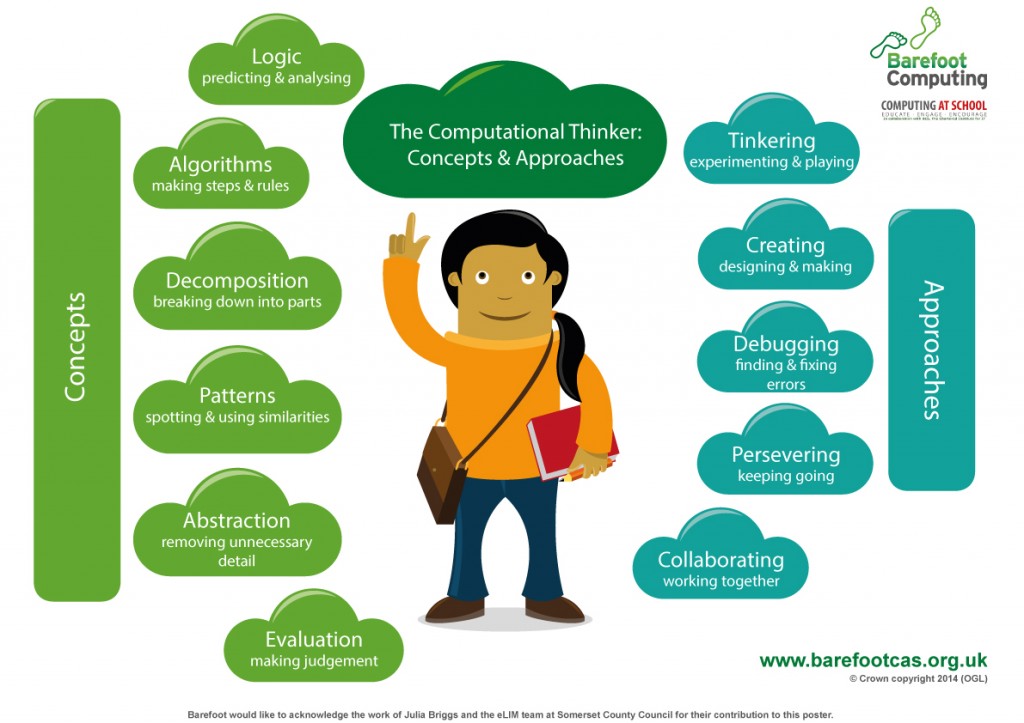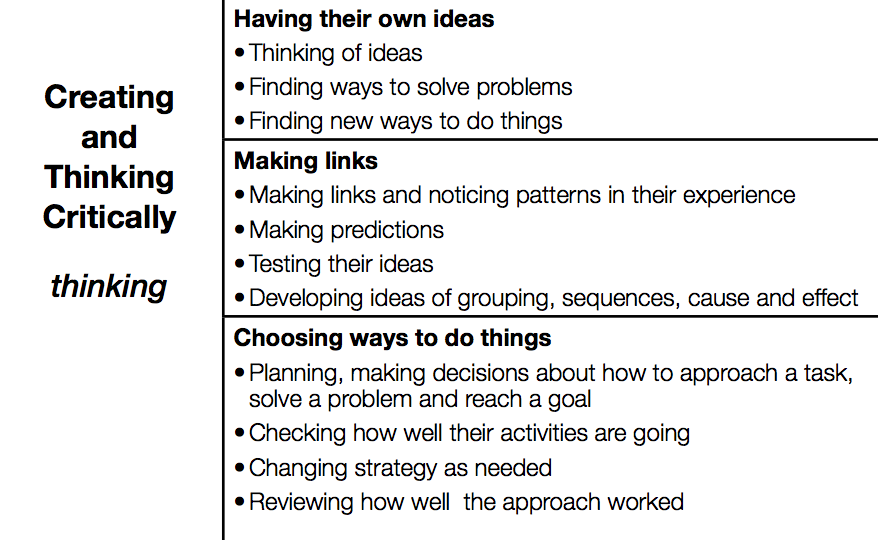Laying the foundations for computing in the early years
Jan 18, 2016
Computing co-ordinators often wonder what to encourage in the nursery or reception class. The easy answer is, ‘not computing!’ However, there is a lot of learning in the Early Years Foundation Stage (EYFS) that provides a foundation for computational thinking.
Computing may not be part of the EYFS Statutory Framework, but there is much that goes on in the EYFS that provides a foundation for computational thinking – the golden thread that runs through Computing in the National Curriculum.
In the Statutory Framework for EYFS, the early learning goal from the ‘technology’ strand in the ‘understanding the world’ area of learning, requires that, ‘children recognise that a range of technology is used in places such as homes and schools’. This is about helping children to understand their place in a world that seems increasingly dominated by technology. We need to help them make sense of this world, as well as planting the seeds for their understanding of the implications of technology in their lives and society. This is the start of ‘digital literacy’ and it extends into Key Stage 1, where children are taught to ‘recognise common uses of information technology beyond school’. Early Years practitioners provide a rich environment in which children can build up an understanding of the world through play. They help children to be curious about technology in real world contexts: what happens inside a microwave? or a photocopier? what happens when Mummy puts her card in the machine outside the bank? what is the machine called? why does she have to type a number in? why does she keep it secret? Through roleplay and natural discussions like these the children make sense of their world.
Although the EYFS ‘technology’ requirement doesn’t explicitly state digital technology, it would be hard to address this properly without giving children an experience of the digital as well as the analogue here. That said, many of us would worry about an environment, whether at home or school, in which young children are spending too much time ‘plugged in’ to screens, narrowing communication and the range of practical experiences from which children learn.
An analogue only education seems of diminishing relevance to the modern world; a digital only education seems a hugely impoverished early childhood experience. Irrespective of access to Bee-Bots, iPads or other digital technology, young children should also be learning outside, making mud pies, climbing trees, playing with puppets, sharing books, making models and chatting with their friends.
The technology early learning goal states that children should ‘select and use technology for particular purposes’. There are a wide range of digital technologies that young children can use playfully and collaboratively, such as digital cameras, audio recorders, tablet computers, phones (smart or otherwise) and simple, programmable robots such as Bee-Bot. As they play with these devices, children will form their own mental model (schema) of how these work, sometimes through chatting to one another, or asking a grown-up, but more often just through play. Note the reference here to ‘select’ – it’s not enough for children to use the tech they’re given: they’ve got to have some say in what they use. Are these things stored somewhere children can access them? How are these things kept charged? Do children know the basics of how to keep themselves and the equipment safe? How will they be shared fairly?
The use of technology can support children across other areas of learning, providing children with new ways to communicate and share their ideas. In the ‘being imaginative’ strand of the ‘expressive arts and design’ area of learning, the early learning goal states the expectation that children ‘use what they have learnt about media and materials in original ways, thinking about uses and purposes. They represent their own ideas, thoughts and feelings through design and technology, art, music, dance, role-play and stories’. The requirement doesn’t specify digital media or information technology, but nor does it preclude it. Alongside working with crayons, pencils, paints and craft materials, there’s ample opportunity for children to use photography, record music they make, video one another and paint with fingers, trackpad or mouse on screen
Further up the primary school, we recognise that there is much more to computing than learning to use digital technology. Computational thinking, understood, after Jeanette Wing, as “taking an approach to solving problems, designing systems and understanding human behaviour that draws on concepts fundamental to computing”, is the golden thread running through the computing curriculum. But computational thinking doesn’t begin in Key Stage 1: the foundations are laid in EYFS.

Barefoot Computing, developed by CAS, offers a model of computational thinking as being made up of both concepts and approaches. It’s widely used in primary schools. All these concepts and approaches can be applied, at least to some extent with four and five year olds. Indeed, some begin earlier still. The nursery or reception classroom is full of opportunities to solve problems. Carrying the water up the hill; solving (or making) jigsaws; building models; spotting and extending a pattern. When children are faced with these problems, the questions that Early Years practitioners would naturally be posing can encourage computational thinking. Here’s some examples:
- Logical reasoning What will happen if I do this? How do you know?
- Algorithms What do I need to do to solve this? Is there a better way?
- Decomposition Can we break this problem up? Could we each do different jobs to solve the problem?
- Patterns Have you solved something like this before? What did you do then? What’s changed?
- Abstraction What’s the most important thing here? Maybe we can draw a picture of this?
- Evaluation What went well? Which way worked best? What would you do differently next time?
The Statutory Framework expects practitioners to consider how children learn and develop in relation to three ‘characteristics of effective learning’:
- playing and exploring – investigate, experience things, and ‘have a go’;
- active learning – concentrate, keep on trying if encountering difficulties, and enjoy achievements; and
- creating and thinking critically – have their own ideas, make links between them, and develop strategies for doing things.
There are very close connections here with the ‘approaches’ to computational thinking that Barefoot Computing uses. Playing and exploring links closely with tinkering and collaborating, as well as abstraction. Active learning is tied to debugging and persevering. Creating and thinking critically connects with Barefoot’s creating, as well as back to the concepts of logical reasoning and algorithms.
So how do we encourage the development of these approaches? This is often about getting the learning environment right. By providing open ended activities that encourage children to use all their senses to observe, discover and engage with the world, we encourage them to tinker, play and explore. Opportunities to take things apart, to build and make models help children to be creative. Getting children to do a jigsaw, recreate a pattern or draw a picture can all encourage them to debug. We provide activities that require longer periods of engagement, concentration and perseverance. Sharing books and toys, playing with puppets or taking part in a nativity play or harvest festival all help develop collaboration.

The non-statutory guidance in Development Matters gives plenty of examples of how these characteristics of effective learning develop, and these link directly with the notion of computational thinking. So, for example, the early stages of logical reasoning will draw on ‘making predictions’ – getting a child to say what will happen if they do or change something, as well as ‘developing ideas of cause and effect’ – can they link their actions to the effects they produce, on screen or off? Abstraction starts early too: representative play captures the essence of a thing, putting to one side much of the detail: children ‘pretend objects are things from experience’ and ‘represent experiences as play’. Debugging, whilst not called that, is common in Early Years with children ‘learning by trial and error’ and ‘persisting with activities when challenges occur’.
As with all learning, we need to recognise the importance of children’s early experiences. If we can get the environment right in these early days, we can set children off on the right foot to develop computational thinking and creativity.
Written by Emma Goto and me for the Spring 2016 edition of Switched On, the CAS Newsletter.
Share